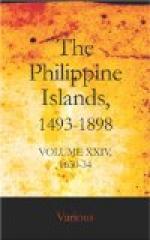[5] Fray Hernando Guerrero, a native of Alcaraz, professed in the convent of San Felipe el Real in 1588. After his arrival at the Philippines, he labored in various Bisayan villages (1599-1613). In 1613, he went to Spain, whence he returned in 1617. He went again to Spain and Rome in 1625. In 1628 he was appointed bishop of Nueva Segovia, and, in 1635, archbishop of Manila. His term in the latter office was marked by contests with the Jesuits, and he was finally excommunicated by a secular priest, and then exiled to Mariveles by the governor, Corcuera—only leaving that island on signing certain conditions. He died July 1, 1641, at seventy-five years of age. See Perez’s Catalogo, pp. 48, 49; and Buzeta and Bravo’s Diccionario, ii, p. 275.
[6] Innumerable are the names which might be cited here of religious who have given proofs of the keenest patriotism, defending the islands with the cross in one hand and the sword in the other: Father Agustin de San Pedro, a discalced Augustinian, called “Father Captain” for his prowess against the Mindanao Moros; the no less famous Father Pascual Ibanez de Santa Filomena, Augustinian Recollect, who died while bravely assaulting the fort of Abisi, Jolo, in 1857; the Jesuit, Father Ducos; the fathers of all the orders, especially the Augustinians in the war with the English; the Augustinian fathers who accompanied General Malcampo on his expedition to Jolo in 1875; Father Ramon Zueco, Recollect, of imperishable memory, besides innumerable others.—Coco.
Continuing his note, Father Coco quotes from Father Fabian Rodriguez in Revista Agustiniana for January 5, 1886, the remarkable defense and military record of the Augustinian Father Julian Bermejo in Cebu, from the latter part of the eighteenth century until his death in 1851.
[7] Fray Hernando de San Jose, the Japanese martyr, whose family name was Ayala, was born at Vallesteros, in 1575, and took his vows in the Augustinian convent of Montilla, May 19, 1593. He arrived in the Philippines in August, 1604, and was soon sent to Japan, whence he returned in 1607 to Manila as procurator. On his return to Japan, he labored in various places, and founded the convent at Nagasaki, of which he was made prior in 1613. He was martyred June 1, 1617. See Diaz’s Conquistas (Valladolid, 1890), pp. 76-103.
[8] Fray Hernando Morales, a native of Montilla, in the province of Cordoba, professed in the Cordoba convent, and on his arrival at the Philippines was sent to labor among the Aetas in Panay. He was minister of Sibucao in 1611, and of Laglag in 1618, in which year he took charge of San Nicolas de Cebu, going later to Dumalag. He died in the last place in 1647.
Fray Felipe Tallada was born in Estepa, in the province of Sevilla. Professing in the city of Sevilla, he was sent to the Philippines, where he labored in the province of Pampanga at various periods from 1605 to 1645. He was definitor and examiner in 1617, and procurator to Spain and Rome in 1618. His death occurred in Betis in 1645. He wrote a life of St. Nicholas of Tolentino in the Pampanga dialect.




